
Manchester Piccadilly is the main railway station of the city of Manchester, in the metropolitan county of Greater Manchester, England. Opened originally as Store Street in 1842, it was renamed Manchester London Road in 1847 and became Manchester Piccadilly in 1960. Located to the south-east of the city centre, it hosts long-distance intercity and cross-country services to national destinations including London, Birmingham, Nottingham, Glasgow, Edinburgh, Cardiff, Bristol, Exeter, Plymouth, Reading, Southampton and Bournemouth; regional services to destinations in Northern England including Liverpool, Leeds, Sheffield, Newcastle and York; and local commuter services around Greater Manchester. It is one of 19 major stations managed by Network Rail. The station has 14 platforms: 12 terminal and two through platforms. Piccadilly is also a major interchange with the Metrolink light rail system with two tram platforms in its undercroft.

Manchester Oxford Road railway station is a railway station in Manchester, England, at the junction of Whitworth Street West and Oxford Street. It opened in 1849 and was rebuilt in 1960. It is the second busiest of the four stations in Manchester city centre.

Stockport railway station serves the large town of Stockport in Greater Manchester, England. It is located 6 miles south-east of Manchester Piccadilly, on a spur of the West Coast Main Line to London Euston.

Wigan North Western railway station is one of two railway stations serving the town centre of Wigan, Greater Manchester, England.
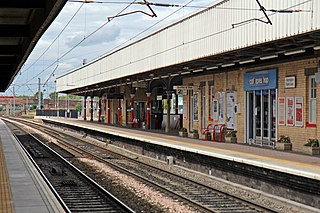
Warrington Bank Quay is one of three railway stations serving the town centre of Warrington in Cheshire, England. It is a principal stop on the West Coast Main Line between London Euston and Glasgow Central. The station is a north–south oriented main-line station on one side of the main shopping area, with the west–east oriented Warrington West and Warrington Central operating a more frequent service to the neighbouring cities of Liverpool and Manchester.
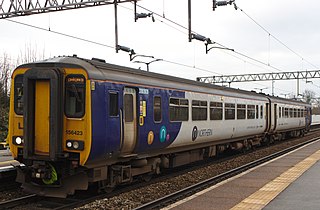
There once were four direct railway routes between Liverpool and Manchester in the North West of England; only two remain, the two centre routes of the four. The most northerly and the most southerly of the four routes are no longer direct lines. Of the remaining two direct routes, the northern route of the two is fully electric, while the now southern route is a diesel-only line. The most northerly of the four has been split into two routes: the western section operated by Merseyrail electric trains and the eastern section by diesel trains, requiring passengers to change trains between the two cities. The fourth route, the most southerly of the four, has been largely abandoned east of Warrington; the remaining section caters mainly for freight trains.

Helsby railway station serves the village of Helsby in Cheshire, England. It is recorded in the National Heritage List for England as a Grade II listed building.
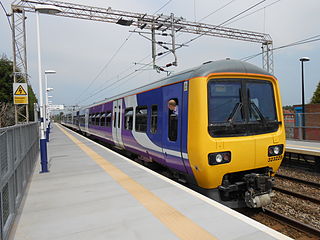
The Styal line is a suburban commuter railway line which runs through south Manchester, England; it commences at Slade Lane Junction, 1.2 miles (1.9 km) south of Manchester Piccadilly, and ends 12 miles (19 km) south at Wilmslow.
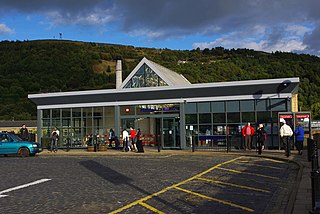
Halifax railway station serves the town of Halifax in West Yorkshire, England. It lies on the Calder Valley line and is 17 miles (27 km) west from Leeds.

Shotton railway station serves the towns of Shotton and Connah's Quay, Flintshire, Wales. It is situated where the Borderlands Line crosses the North Wales Coast Line. All passenger services are operated by Transport for Wales, which manages the station.

Chester railway station is located in Newtown, Chester, England. Services are operated by Avanti West Coast, Merseyrail, Northern and Transport for Wales. From 1875 to 1969, the station was known as Chester General to distinguish it from Chester Northgate. The station's Italianate frontage was designed by the architect Francis Thompson.
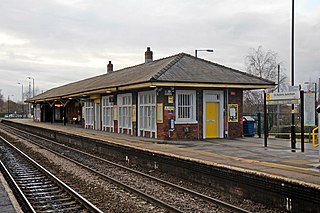
St Helens Junction railway station is a railway station serving St Helens, Merseyside, England. It is in Sutton, three miles southeast of St Helens town centre. The station is on the electrified northern route of the Liverpool to Manchester Line, 12 miles (19 km) east of Liverpool Lime Street. The station and all trains calling there are presently operated by Northern Trains.

Newton-le-Willows railway station is a railway station in the town of Newton-le-Willows, in the Metropolitan Borough of St Helens, and at the edge of the Merseytravel region. The station is branded Merseyrail. The station is situated on the northern route of the Liverpool to Manchester Line, the former Liverpool and Manchester Railway which opened in 1830. It is a busy feeder station for nearby towns which no longer have railway stations, such as Golborne, Billinge and Haydock. There is also a complimentary bus shuttle service to Haydock Park Racecourse on certain racedays.

The Liverpool–Wigan line is a railway line in the north-west of England, running between Liverpool Lime Street and Wigan North Western via St Helens Central station. The line is a part of the electrified Merseyrail Liverpool to Wigan City Line. The stations, and all trains serving it, are operated by Northern Trains, however the stations are branded Merseyrail using Merseyrail ticketing.
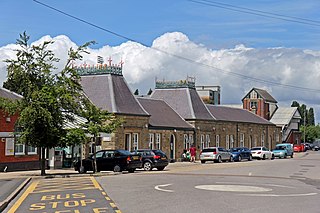
Wrexham General is the main railway station serving the city of Wrexham, north-east Wales, and one of the two serving the city, alongside Wrexham Central. It is currently operated and mostly served by Transport for Wales, with some additional services provided by Avanti West Coast to London Euston.

Frodsham railway station serves the town of Frodsham, Cheshire, England. The station is managed by Transport for Wales. It was opened along with the line in 1850 and the station building is recorded in the National Heritage List for England as a designated Grade II listed building. This was restored in 2012 and is in private ownership.
There are various modes of transport available in Warrington.

Huyton railway station serves Huyton in Merseyside, England. The station is an interchange between the Liverpool-Wigan Line and the northern route of the Liverpool-Manchester Line which diverge soon after the station. It is one of the busier stations on the lines and close to the shopping centre and bus station.

The City Line is the brand name used by Merseytravel on suburban rail services in the Liverpool City Region starting eastwards from the mainline platforms of Liverpool Lime Street railway station.

The Chester–Warrington line is a railway line running between Chester and Warrington Bank Quay in North West England.




















